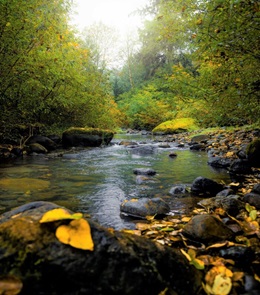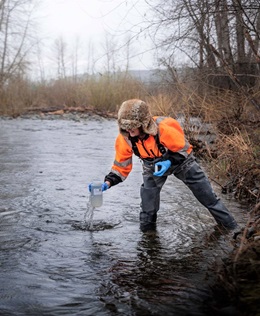
History of Stream and River Monitoring Program
The King County Stream Monitoring Program is designed to ensure our waters continue to support the different ways we use them. The goal is to protect the investments in water quality improvement made by the people of King County since the 1950s. Prior to the 1950’s, untreated wastewater flowed into Lake Washington, Puget Sound, and other waterways, polluting the water. In 1958, voters approved an initiative for the formation of the Municipality of Metropolitan Seattle (Metro). Metro had two responsibilities under the initiative. First, it would create a regional wastewater treatment system to treat the sewage. Additionally, it would monitor the waters receiving the treated effluent to ensure there were no harmful impacts. Four wastewater treatment plants were constructed--at Renton, West Point, Carkeek Park and Richmond Beach. The plants were up and running by 1966. Metro began monitoring temperature and bacteria levels in the Green River and Pipers Creek as part of the receiving water monitoring. These were the first monitoring sites of the present-day program.

The sampling strategies and the number of sampling sites have varied over time but the objective of tracking and maintaining water quality have remained. Through 2005, sites in the program were limited to WRIAs 8 and 9. The WRIA 15 sites on Vashon Island were added in 2006. In 2009, budget constraints resulted in a significant decrease in monitoring program budget. The loss of funding resulted in a loss of nearly half of the monitoring sites, leaving only 32 sites. King County Council passed a Surface Water Management (SWM) fee increase beginning in 2011, funding twelve new sites in WRIA 7. Boise Creek, in WRIA 10, was also added in 2011. In early 2013 King County Council reinstated funding which resulted in the restoration of dropped sites and addition of new sampling sites. Today, the program includes 75 sites across WRIAs 7, 8, 9, 10, and 15, monitored monthly.

The data from the stream monitoring program are analyzed with the following objectives:
- Characterize the general water quality status of the stream
- Determine if applicable State and Federal water quality criteria are met
- Identify long-term water quality trends
Continued ongoing monitoring is important to understand if new problems are appearing that can impact water quality and thereby the health of people who use our regional waters. The long-term environmental impacts of all types of pollution that affect the quality of lakes and streams can only be evaluated by sampling at multiple sites throughout the watershed.